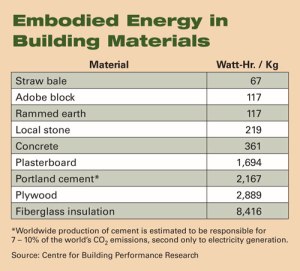 Embodied energy is one part of a building material’s overall environmental impact. Embodied energy is the total energy required for the extraction, processing, manufacture and delivery of building materials to the building site. Energy consumption produces CO2, which contributes to greenhouse gas emissions, so embodied energy is considered an indicator of the overall environmental impact of building materials and systems.
Embodied energy is one part of a building material’s overall environmental impact. Embodied energy is the total energy required for the extraction, processing, manufacture and delivery of building materials to the building site. Energy consumption produces CO2, which contributes to greenhouse gas emissions, so embodied energy is considered an indicator of the overall environmental impact of building materials and systems.
Unlike the life cycle assessment, which evaluates all of the impacts over the whole life of a material or element, embodied energy only considers the front-end aspect of the impact of a building material. It does not include the operation or disposal of materials.
Why reduce embodied energy?
Energy consumption during manufacture can give an approximate indication of the environmental impact of the material, and for most building materials, the major environmental impacts occur during the initial processes. The total amount of embodied energy may account for 20% of the building’s energy use, so reducing embodied energy can significantly reduce the overall environmental impact of the building.
Embodied energy must be considered over the lifespan of a building, and in many situations, a higher embodied energy building material or system may be justified because it reduces the operating energy requirements of the building. For example, a durable material with a long lifespan such as aluminium may be the appropriate material selection despite its high embodied energy. As the energy efficiency of a building increases, reducing the energy consumption, the embodied energy of the building materials will also become increasingly important.
How is embodied energy measured?
Embodied energy is measured as the quantity of non-renewable energy per unit of building material, component or system. It is expressed in megajoules (MJ) or gigajoules (GJ) per unit weight (kg or tonne) or area (m2) but the process of calculating embodied energy is complex and involves numerous sources of data.
Reducing embodied energy
Buildings should be designed and materials selected to balance embodied energy with factors such as climate, availability of materials and transport costs. Lightweight building materials often have lower embodied energy than heavyweight materials, but in some situations, lightweight construction may result in higher energy use. For example, where heating or cooling requirements are high, this may raise the overall energy use of the building.
Conversely, for buildings with high heating or cooling requirements but where there is a large diurnal (day/night) temperature range, heavyweight construction (typically with high embodied energy) and the inclusion of high levels of insulation can offset the energy use required for the building. When selecting building materials, the embodied energy should be considered with respect to:
• the durability of building materials.
• how easily materials can be separated.
• use of locally sourced materials.
• use of recycled materials.
• specifying standard sizes of materials.
• avoiding waste.
• selecting materials that are manufactured using renewable energy sources.
